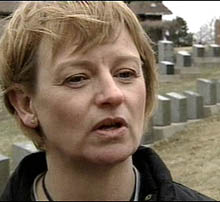Titanic enthusiasts have gathered in Halifax this weekend to mark the 95th anniversary of the ship's sinking and explore the city's numerous connections with the ill-fated ocean liner.
The three-day convention has attracted more than 100 members of Titanic societies from countries including the United States, Sweden, Germany and Britain for lectures, gravesite tours and visits to museums featuring artifacts from the famed vessel.

Nikki Allen, seen here visiting one of the Halifax graveyards where Titanic passangers are buried, travelled from Britain for the anniversary.
On April 14, 1912, RMS Titanic struck an iceberg in the North Atlantic, and began taking on water. Within hours the ship sank, claiming the lives of more than 1,500 people. More than 700 people survived.
Organizers said Halifax, where more than 100 of the dead are buried, was the ideal location to mark the 95th anniversary.
"It's truly an amazing place. … The saddest part is of course the graveyards,'' said Steve Rigby of the British Titanic Society, which organized the three-day convention.
"It's a rather special place to come to remember these people who died.''
Closest major port
When Titanic sank, Halifax was the closest major port with rail service, and several ships were sent out with the grim task of recovering the bodies of those who had been lost. Only about 335 were ever recovered.
"There are millions of stories … about those who survived and those who didn't," Nikki Allen told CBC News Saturday.
Allen came all the way from England to Halifax for her second trip to Fairview Cemetery, where 121 of Titanic's victims were laid to rest. Another 29 Titanic victims are buried in Halifax's Mount Olivet Cemetery.
Edith Haisman was just 16 when she made the voyage on Titanic. She and her mother survived, but her father perished.
"He stood on the deck and he was smoking a cigar and, very calmly, as they were lowered down the ship's side, he said 'I'll see you in New York,' " Edith's son David Haisman told CBC News Saturday. "Those were the last words they heard from him."
The 1997 Hollywood blockbuster Titanic re-ignited the public's passion for the story and opened the tragedy to younger generations.
Ralph White, a cinematographer who worked with director James Cameron filming the film's underwater scenes, told CBC News he has seen the wreck of Titanic 39 times, but each time carries a poignant meaning for him.
"You cannot come up on that shipwreck without a feeling of awe," he said.